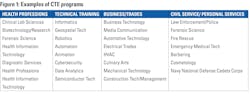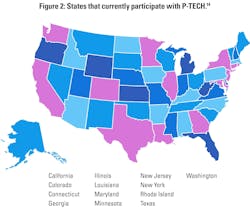Early high school education: A way to growing the laboratory profession through the P-TECH program
Healthcare workers have seen, and continue to see, staffing shortages in all areas – physicians, nurses, X-ray technicians, laboratory scientists, and others. Staffing shortages in the clinical laboratory were an issue even before the COVID-19 pandemic. The Bureau of Labor Statistics noted that as of 2023, there are 344,200 technicians/technologists with a projected need of an additional 18,000+ in the next ten years. Furthermore, it has been noted that nearly half (47%) of healthcare workers will leave their jobs within the next year. The projected shortage for the United States and Canada has been projected to be between 7–11%, with some rural areas facing a 25% vacancy rate.1
These concerns are due to a number of issues. The average age of laboratory professionals is over 50 years, of which 60% are approaching retirement age (“silver tsunami”). Another issue seen in many of the healthcare professions is burnout. Prior to the COVID-19 pandemic, burnout in the laboratory occurred but was exacerbated by the pandemic. In one study, only 12% of laboratory professionals were “extremely likely to stay in the diagnostics field.”2 Heavy workload, lack of staffing, and upended work hours have contributed to burnout. Another confounding issue is the decreased number of laboratory science graduates, due in part to the 15% decrease in the number of educational programs available in the last decade. Approximately 4,900 students graduate annually from two- and four-year programs, yet there are over 9,000 job openings.1
As laboratories face staffing shortages, the impacts on turnaround times, delayed diagnoses, reduced capacity to initiate new testing services, and increased healthcare costs become real issues. Nearly half of all laboratories find recruitment of new clinical laboratory scientists difficult, impacting up to 65% of laboratories. As they retire or leave, they take with them years of experience. This is at a time when technology and medical treatments have become even more sophisticated, requiring highly skilled professionals to provide laboratory services to a growing aging population. Also, dealing with worldwide outbreaks (e.g., COVID, dengue, Listeria, and measles) has severely tested many laboratories' capacities in the last few years. In attempting to address these staffing shortages, public schools, universities, and businesses have collaborated by offering scholarships and other incentives to create direct pathways from education and training to employment.2-5
College and technical education (CTE)
While many laboratories struggle to recruit staff, various options have been recognized, of which one that has a long-term promise of meeting this need: College and Technical Education (CTE). CTE programs start in 9th grade and serve as an educational pathway that focuses on skills and the knowledge needed for employment in various trades and professions. CTE programs offer insights into various professional, technical, and civil service opportunities for students to explore and prepare themselves for the future (See Figure 1). In addition, students are exposed to learning ‘soft skills,’ such as communication, teamwork, problem-solving, and critical thinking. There are some challenges to these program as they may vary by school: not every college or career opportunity may be available, as well as other factors such as adequate grade point averages, availability to participate in work-based activities, internship eligibility, and loss of interest by the student in participating in the program they selected, may impact the full success of certain programs.6
All 50 states have secondary CTE programs that prepare students in transitioning to employment or post-secondary education. CTE programs are initiated in high schools in grade 9, continuing through high school and into the first two years of college (grades 9–14). In preparing students for future employment opportunities, students opt to participate in a particular program with the intent of learning about and experiencing various professions that are of interest to them. These programs are funded by federal and state governments as authorized through the Strengthening Career and Technical Education for the 21st Century Act, thus ensuring access to career and technical education to meet today's demands. Collaborating high schools and colleges provide the foundation and partner with local businesses, healthcare facilities, and education organizations to ‘groom’ students by piquing their interest in various careers. With the many advances in technology, many of today’s jobs require a post-secondary degree, though not necessarily a four-year degree. Many jobs that only required a high school degree have disappeared and have in some cases, been replaced by these “new-collar” types of jobs.7,8
Pathways in Technology Early College High School (P-TECH)
Pathways in Technology Early College High School (P-TECH) is a type of intensified CTE program that combines high school and college, focusing on various careers, including healthcare. P-TECH serves students from primarily underserved backgrounds, allowing students the opportunity to attend college with external support, students who otherwise may have gone without a higher education. The first P-TECH program originated in Brooklyn, NY in 2011, through a collaboration between IBM, the New York City Department of Education, and the City University of New York.9 This concept quickly spread and is now in 13 states (See Figure 2). Globally, there are over 300 P-TECH schools in 28 countries serving over 150,000 students. More than 600 large and small businesses serve as business partners in developing a pipeline to employment for these students.10,11 This public-private partnership provides opportunities for students through mentorship/internship experiences that they would not otherwise be exposed to.
P-TECH blends high school, community college, and workplace skills into a single program commencing in 9th grade and continuing through 14th grade, culminating with an associate’s degree in science, technology, engineering, or math (STEM). Students are provided with the opportunity to acquire academic, technical, and workplace skills to prepare them for high-skilled job opportunities. In these six years, students are mentored, allowed to job shadow, and may receive an internship with employer-partners, resulting in prime candidates for securing a job. In addition, financial support is generally covered with no cost to students or their families. Many schools receive public high school funding, often with support from business partners. For example, Bloomberg Philanthropies awarded $250 million to ten cities funding P-TECH programs. Boston Public Schools received $37.8 million in grants to fund their P-TECH programs.9,12,13
P-TECH outcomes
The successes of P-TECH students are reflected in their greater attendance rates, grade promotions, and completed college courses, with some students achieving as much as four times the national average. In one study, students earned more high school and college credits than those not in a P-TECH program.6 Also, those in a P-TECH program were more likely to earn a postsecondary degree compared to others not in P-TECH. In New York City’s program, almost half (46%) of the P-TECH enrolled students had at least one college-level course or more than non-participants, with 38% more likely to have had an internship during high school. Male students in the P-TECH program tended to fare better than female students in achieving a degree, in opposition to national trends where females do better than males.6,9
Why is earlier education important?
As noted, laboratory staffing shortages are prevalent across the United States, with some regions facing up to 20% vacancies.3 Increasing wages, providing professional development opportunities, implementing work-life balance initiatives, and offering sign-on bonuses are some tactics currently used to attract new employees. These short-term fixes may be enticing to some, but the question remains: Will the number of properly trained individuals be enough to fill current and future vacancies? While most students know of and have been exposed to doctors and nurses, few may be aware of other equally important healthcare professions, especially those in the laboratory. Laboratory professionals who have participated in job fairs, social media, networking events, or other recruitment venues may be familiar with this issue. P-TECH programs can provide a reasonable and direct path to introducing, educating, and preparing students to join a professional laboratory workforce.
Youths gain the skills and training that will result in a fruitful career, an opportunity that may not have otherwise been available. Such programs can go beyond solving staffing shortages by addressing student absenteeism, reducing the number of high school dropouts, and promoting graduation rates. In a 2021 study from the University of Chicago, 92,511 Chicago youths between the ages of 16–19 were neither working nor in school.9 Similar numbers are reflected in other cities. Programs such as P-TECH can be life-changing for some, creating a path forward to a more productive and enriching life.
What can we do to prepare for the next generation of laboratory professionals? P-TECH programs depend on ‘coaches’ who assist program advisors in guiding, counseling, and educating students on the employment opportunities available in laboratory medicine and other healthcare services. Coaches can also arrange opportunities for students to shadow laboratory professionals at their institutions so they may get firsthand experience through personal involvement. Because P-TECH programs already exist in many cities across the country, seeking out a nearby program and offering one’s experiences and wisdom is one way to address the staffing shortage. High schools and their partners wishing to develop a P-TECH program can follow a multi-year roadmap offered through the P-TECH organization (ptech.org) to assist in designing a structured program that provides flexibility in activities to meet specific needs.12 This approach to early student engagement aligns educational, professional, and social opportunities to create a strong future workforce.
References
1. Robinson AT. Rhode RE. Workforce in the shadow of healthcare –an update on the survival status of laboratory medicine and public health. Biomed J Sci Tech Res. 2024;54(5). doi:10.26717/bjstr.2024.54.008604.
2. Hanson B, QuidelOrtho. What’s behind today’s clinical laboratory staffing shortage? Selectscience.net. January 14, 2025. Accessed April 10, 2025. https://www.selectscience.net/article/what-s-behind-today-s-clinical-laboratory-staffing-shortage.
3. The growing med tech shortage: A critical challenge. Prsglobal.com. October 22, 2024. Accessed April 10, 2025. https://prsglobal.com/blog/the-growing-med-tech-shortage-a-critical-challenge.
4. Nadeau K. MLO’s 2024 survey of laboratory professionals. Medical Laboratory Observer. August 26, 2024. Accessed April 10, 2025. https://www.mlo-online.com/management/careers/article/55131251/mlos-2024-survey-of-laboratory-professionals.
5. Golab K. The impact of burnout on clinical lab staff. Today’s Clinical Lab. September 2, 2021. Accessed April 10, 2025. https://www.clinicallab.com/the-impact-of-burnout-on-clinical-lab-staff-25911.
6. Rosen R, Alterman E, Treskon L, Parise L, Dixon M, Wuest C. P-TECH 9-14, pathways to success. MDRC. October 2023. Accessed April 10, 2025. https://files.eric.ed.gov/fulltext/ED632477.pdf.
7. Kelley B, Bloomquist L, Peisach L. 50-state Comparison: Secondary career and technical education. Education Commission of the States. March 2, 2023. Accessed April 10, 2025. https://www.ecs.org/50-state-comparison-secondary-career-and-technical-education-2023/.
8. P-tech. Roadmap. P-tech.org. Accessed April 10, 2025. https://www.ptech.org/getting-started/roadmap/.
9. Vallas PG. Bridging educational gaps, building brighter futures: Paid high school work-study programs. The Manhattan Institute. April 2024. Accessed April 10, 2025. https://media4.manhattan-institute.org/wp-content/uploads/bridging-educational-gaps-building-brighter-futures.pdf.
10. About P-TECH. Ppinys.org. Accessed April 10, 2025. https://ppinys.org/about-p-tech.
11. Shead T. The evolution & significance of P-TECH. Linkedin.com. August 25, 2023. Accessed April 10, 2025. https://www.linkedin.com/pulse/evolution-significance-p-tech-taylor-shead.
12. Our schools. P-tech.org. Accessed April 10, 2025. https://www.ptech.org/p-tech-network/our-schools/north-america/more-schools/.
13. Washington KN. Bridging the academic and equity gap to pathways in technology early college programs (P-TECH). Dissertation, Hampton University. December 2024. Accessed April 10, 2025. https://www.proquest.com/openview/e5096f0c77f39d59a8f6cda3c987c6fa/1?pq-origsite=gscholar&cbl=18750&diss=y.
14. Our schools. P-tech.org. Accessed May 1, 2025. https://www.ptech.org/p-tech-network/our-schools/usa/more-schools/.
About the Author

Anthony Kurec, MS, MASCP, MLT, H(ASCP)DLM
is Clinical Associate Professor, Emeritus, at SUNY Upstate Medical University in Syracuse, NY. He is also a member of the MLO Editorial Advisory Board.

Amy Stewart, MS
is the Workforce Development Specialist at Partners for Education & Business, the K-16 arm of workforce development at The Manufacturers Association (MACNY). As part of the PEB team, Amy collaborates with schools to connect the classroom with industry, specifically within STEM. Henninger High School’s P-TECH program is one of the school partnerships, where she serves as the industry liaison to set up site visits, job shadowing, career coaching, and career fairs. She has a Master’s in Student Affairs Counseling from Syracuse University.

Jessica Teifke, M.Ed.
in STEM Education, is the Work-Based Learning Coordinator, Henninger High School (Syracuse City School District). Jessica leads Henninger High School’s P-TECH health-professions pathway, integrating dual-enrollment courses and industry internships. A former CEO of the Institute for the Application of Geospatial Technology with 15 years in STEM education, she helps connect students to college credits and high-demand careers.


